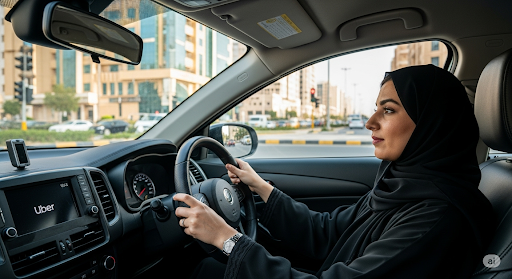
Since the lifting of the driving ban in 2018, ride-hailing giants like Uber have empowered Saudi women to become drivers, boosting their economic participation and autonomy. Over 500% growth observed in female ride-hailing operation from 2020 to 2021, rising from 600 to nearly 3,900 drivers. Nearly three-quarters of women drivers report using Uber as a source of financial stability, with more than 77% feeling safe while working. Saudi Arabia’s 2018 repeal of the women-driving ban was a landmark societal shift, granting women a long-awaited right. This reform unlocked ripple effects across sectors, particularly transportation and employment. Ride-hailing services like Uber and Careem quickly tapped into this momentum, launching targeted programs to recruit female drivers. Careem began hiring “captainahs” in 2018 while Uber introduced initiatives like Masaruky and Women Preferred View to support women drivers in joining the gig economy. The figures underscore this cultural shift: As per Saudi Gazette, in 2021, the number of Saudi women working as ride-hailing drivers soared from around 600 to nearly 3,900, a 500% year-over-year increase. Over 21 million ride-hailing trips were operated in Saudi Arabia across 27 licensed apps, highlighting the scale and demand of this newly opened sector. Riding apps have gone from novelty to necessity, providing women with newfound mobility and a chance to reshape their roles in society. Uber’s internal studies offer compelling insights: Around 56% of female Saudi drivers reported using Uber to support their families. Nearly 77% said driving made them feel safer, and around 47% experienced improved financial stability. As Mohammad Aljuraish, Uber’s Saudi GM, noted, driving is not just a job, it’s a pathway to empowerment for women aged 21–46. Recognizing cultural norms, Uber rolled out the Women Preferred View feature, allowing female drivers to accept only female riders. Initially piloted in 2019, it saw high adoption rates as more women opted to drive exclusively for women passengers. More recently, Uber introduced GigSister, a women’s driver community initiative, to share experiences, build support networks, and reinforce safety. These shifts are more than economic, they are symbolic: Women’s labour participation rose to 35.8% by Q2 2024, surpassing Vision 2030 targets. Women driving themselves, and inviting other women as passengers, challenges traditional gender roles and fosters a sense of independence. Importantly, many women report feeling more secure and empowered once they could step into the driver’s seat—literally and metaphorically. Despite this progress, challenges remain: Societal conservatism still frames some gender interactions. Female drivers cite licensing barriers, vehicle access, and fluctuating demand as structural hurdles. Ride-hail platforms and regulators must continue refining tools like Women Preferred View and safety policies to foster inclusion. Seven years after the driving ban was lifted, Saudi Arabia’s ride-hailing transformation illustrates how a simple right of driving can unlock profound societal change. Uber’s gender-centric features, combined with government reforms under Vision 2030, have given women autonomy behind the wheel. For countless Saudi women, driving with Uber is no longer about transportation, it is a vehicle to independence and social participation. As more platforms innovate and the cultural fabric evolves, this momentum may accelerate women’s empowerment deeper into public and economic life.






